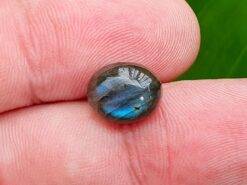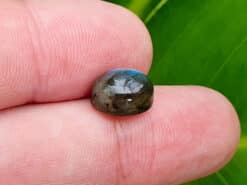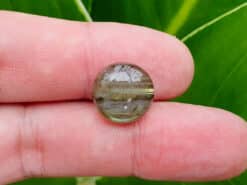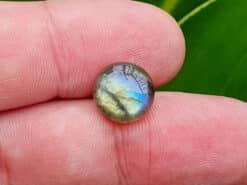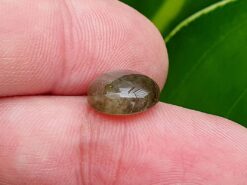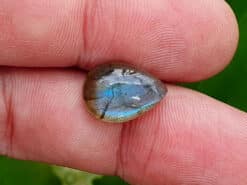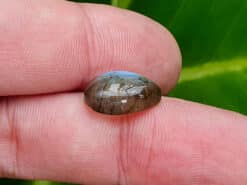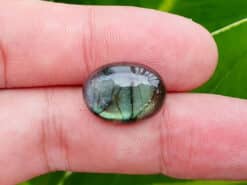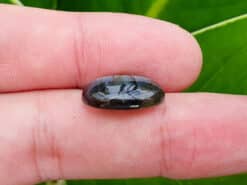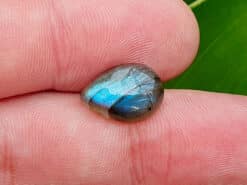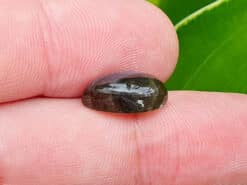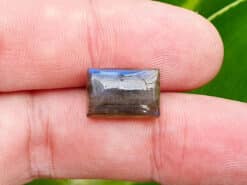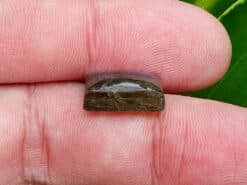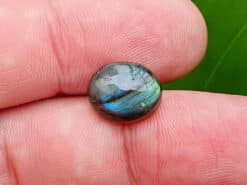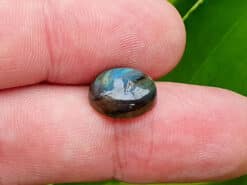Labradorite
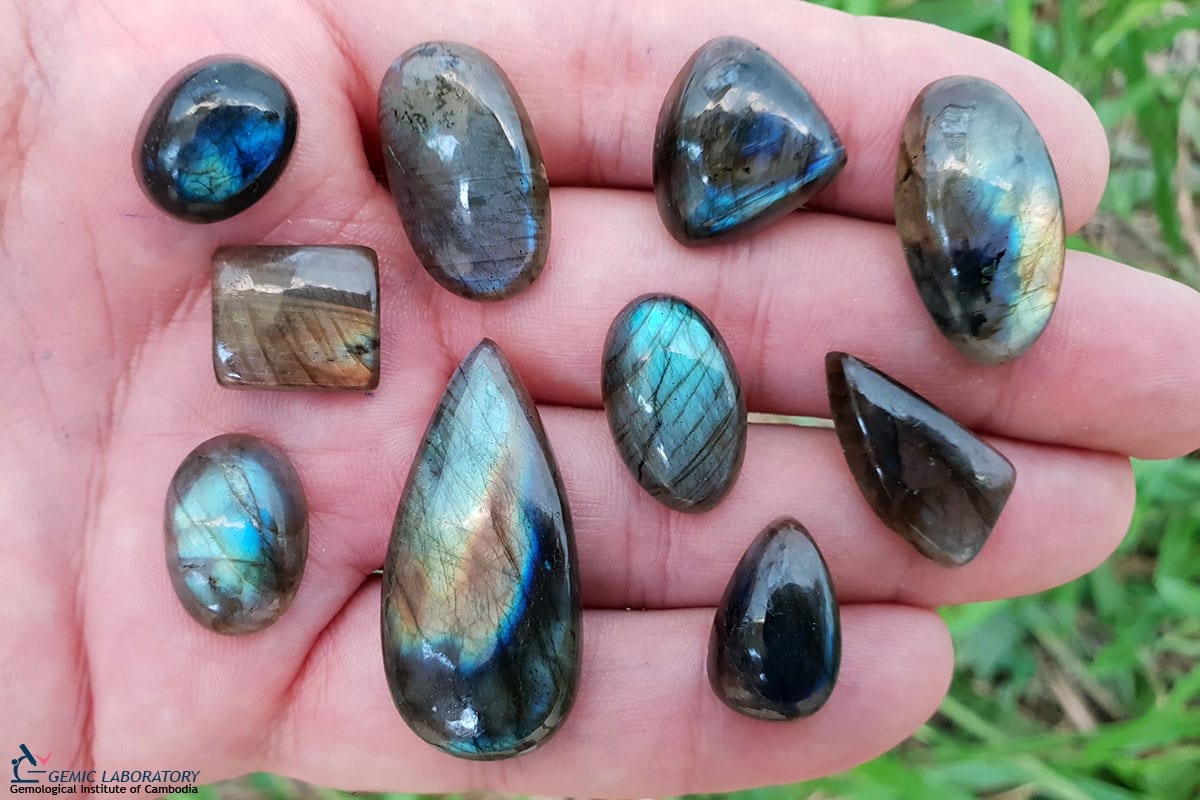
Labradorite crystal stone meaning and metaphysical properties.
Buy natural labradorite in our shop
Labradorite properties
A feldspar mineral, is an intermediate to calcic member of the plagioclase series. It has an anorthite percentage of between 50 and 70. The specific gravity ranges from 2.68 to 2.72. The streak is white, like most silicates. The refractive index ranges from 1.559 to 1.573.
And the twinning is common. As with all plagioclase members, the crystal system is triclinic. And three directions of cleavage are present. Two of which are nearly at right angles.
And they are more obvious, being of good to perfect quality. The third direction is poor. It occurs as clear, also white to gray, blocky to lath shaped grains in common mafic igneous rocks. Auch as basalt and gabbro, as well as in anorthosites.
The geological type area for labradorite is Paul’s Island near the town of Nain in Labrador, Canada. It has also been reported in Norway, Finland and various other locations worldwide.
The stone occurs in mafic igneous rocks. And it is the feldspar variety most common in basalt and gabbro. The uncommon anorthosite bodies are composed almost entirely of labradorite. It is also found in metamorphic amphibolites and as a detrital component of some sediments. Common mineral associates in igneous rocks include olivine, also pyroxenes, amphiboles and magnetite.
Labradorescence
Labradorite displays an iridescent optical effect known as labradorescence. The term labradoresence was coined by Ove Balthasar Boggild, who defined it labradorization as follows.
Labradorization is the peculiar reflection of the light from submicroscopical planes orientated in one direction. Rarely in two directions, these planes have never such a position. They can be expressed by simple indices. And they are not directly visible under the microscope.
The cause of this optical phenomenon is phase exsolution lamellar structure. The effect is visible when the lamellar separation is between 128 to 252 nm. The lamellae are not necessarily parallel. And the lamellar structure is found to lack long range order.
The lamellar separation only occurs in plagioclases of a certain composition. In particular, those of calcic labradorite and bytownite. Another requirement for the lamellar separation is very slow cooling of the rock. It contains the plagioclase.
Slow cooling is required to allow the Ca, elso Na, Si, and Al ions to diffuse through the plagioclase. And produce the lamellar separation. Therefore, not all stones exhibit labradorescence. They might not be the correct composition. Or they cooled too quickly. And not all plagioclases that exhibit labradorescence are labradorites.
Some gemstone varieties of labradorite exhibiting a high degree of labradorescence are called spectrolite.
Labradorite meaning and metaphysical properties
The following section is pseudo scientific and based on cultural beliefs.
Labradorite crystal stone meaning and metaphysical properties are considered as one of the most powerful protectors. The gemstone creates a shield for auras and protects against negativity of the world. It is said to temper the negativity within ourselves as well.
FAQ
What are the healing properties of labradorite?
A stone of transformation, Labradorite is a useful companion through change, imparting strength and perseverance. It balances and protects the aura, raises consciousness and grounds spiritual energies. Excellent for strengthening intuition – promoting psychic abilities.
What are the benefits of labradorite?
It is excellent for strengthening intuition – promoting psychic abilities. The crystal meaning and metaphysical properties banishes fears and insecurities, and strengthens faith in the self and trust in the universe. It stimulates the imagination and calms an overactive mind , developing enthusiasm and new ideas.
What chakra is labradorite good for?
The stone is known for its changing colors, so it is no surprise this gemstone is known as a stone of transformation, enhancing strength of will and inner worth. The gemstone is said to stimulate the throat chakra.
Can I wear labradorite everyday?
The great thing about crystals is that they always look fashionable and elegant. You can wear them as everyday jewelry to get the most benefit from their energy.
Which hand should wear labradorite?
The gemstone in the ring form is known to be worn in the ring finger of the correct hand, which is right hand for the right-handed while left for the left-handed ones. The stone should be worn during the Shukla Paksh on Friday evening.
Can labradorite go in water?
It is slightly water sensitive and its beautiful shine and lustre can disintergrate if submerged in water for a long time. The stone is fine with a quick rinse in running water, i.e rain or a waterfall but when left for any time in a pool, it will deteriorate.
How can you tell fake labradorite?
Fake gemstones will not have that change of color as the angles change. It will often look dull or gray at one angle the bright blue or red as it rotates, fakes will stay constantly colorful.
Does labradorite scratch easily?
The crystal only ranks at 6 to 6.5 on the Mohs scale which is softer than quartz. This means that it can be scratched quite easily, even by dust. Quartz is a major component of dust.
Does labradorite fade in the sun?
Sun exposure can cause fading to your crystals as well as make them more brittle or extremely hot. It is generally known to be okay with light. Extended periods of direct sunlight may cause deeply colored stone to fade over time.
Where should you place a labradorite stone in your home?
Keep large pieces of crystal in your living room. It is believed to purify the negative vibrations off the surrounding area. People tend to bring their energies to your home with them. Their negative vibe can stay even after they physically leave the room.
Is labradorite a lucky stone?
The stones are a mystical protector. Taking on the characteristic energies of both the Sun and the Moon. It is helping to assure success and bring changes in the quality of life.
Is labradorite the same as moonstone?
The gem is classified as a plagioclase and calcium sodium feldspar. Moonstone is an orthoclase and potassium sodium feldspar. That is why they are sister stones. They are in the same feldspar family but gemologically they are different.
Why does labradorite glow?
It is an unusual mineral. It can display a beautiful iridescent play of colors, caused by internal fractures in the mineral that reflect light back and forth, dispersing it into different colors. This effect, known as labradorescence, gives to the stone its appeal and fame.
Natural labradorite for sale in our gem shop
We make custom made labradorite jewelry as engagement rings, necklaces, stud earrings, bracelets, pendants… Please contact us for a quote.

